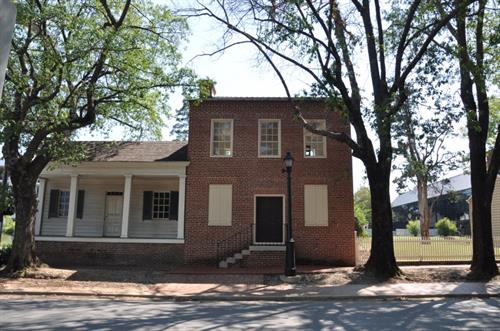Historic Homes
Historic Arkansas Museum is a historic site museum of Arkansas's frontier days. Explore restored antebellum homes on their original block, including the c. 1827 Hinderliter Grog Shop, Little Rock's oldest surviving structure, as well as the Brownlee House, McVicar House and the Woodruff Print Shop.
To tell the story of agriculture in early Arkansas, the museum's grounds are also home to the c. 1830s Plum Bayou Log House which has been relocated to Historic Arkansas Museum from its original location near Scott, Arkansas. As you visit the Plum Bayou Log House, you will be surrounded by the 1850s Farmstead, which provides an authentic 19th century context for the main house.
Brownlee House - Late 1840s
Historic Arkansas Museum is a historic site museum of Arkansas's frontier days. Explore restored antebellum homes on their original block, including the c. 1827 Hinderliter Grog Shop, Little Rock's oldest surviving structure, as well as the Brownlee House, McVicar House and the Woodruff Print Shop.
To tell the story of agriculture in early Arkansas, the museum's grounds are also home to the c. 1830s Plum Bayou Log House which has been relocated to Historic Arkansas Museum from its original location near Scott, Arkansas. As you visit the Plum Bayou Log House, you will be surrounded by the 1850s Farmstead, which provides an authentic 19th century context for the main house.
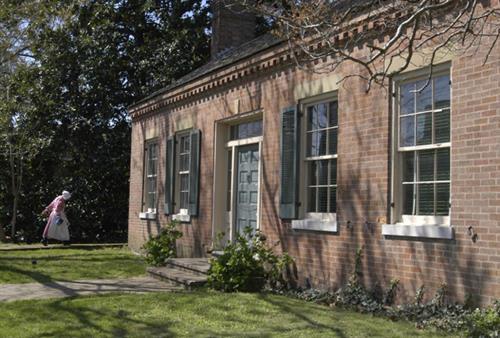
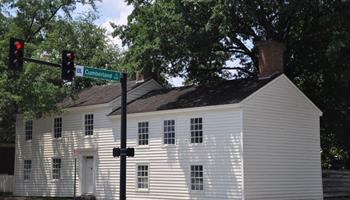
Hinderliter Grog Shop - c. 1826-27
Now Little Rock's oldest building, the Hinderliter Grog Shop began as a log structure in 1826-27 built by Jesse Hinderliter, a man of German descent. It was his home and business, where he lived with his wife and two slaves until his death in 1834. Popular folklore associates the building with the last meeting of the territorial legislature of 1835. Red oak logs and cypress flooring were used in the grog shop's construction. The clapboard siding and porch were later additions. Inside, the hand-carved federal mantel in the formal dining room shows that style was important, even in a log house on the frontier.
McVicar House - Late 1840s
James McVicar built this wooden house, using white oak logs and square pegs, on the same block his friend Robert Brownlee built a brick home. Their homes follow the symmetrical 1840s style with a large central hall bordered by two rooms of equal size. It is a sophisticated version of the "double pen" log house seen across Second Street. McVicar was director of the state penitentiary, a Mason, a veteran of the Mexican War and a slaveholder. In 1849 he and Brownlee led the Little Rock-California Company to the California Gold Rush. McVicar later returned to Little Rock and married.
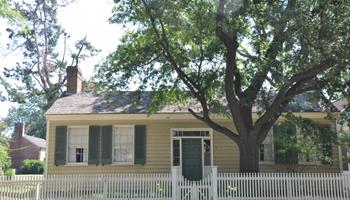
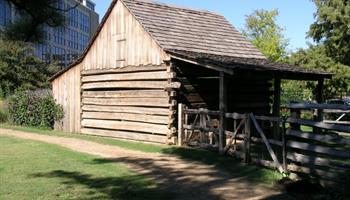
Plum Bayou Log House - Mid-19th Century
The written history of this home begins in 1856. In that year it was found abandoned and in need of repair to house the Pemberton family who had just moved from North Carolina. It is built of logs from ancient cypress and has brick chimneys (few stones are found in the Delta where it was built). Originally located on Plum Bayou near the farming community of Scott, the house was moved 20 miles to Historic Arkansas in the 1970s.
1850s Farmstead
As you visit the Plum Bayou Log House, you will be surrounded by the 1850s Farmstead, which provides an authentic 19th century context for the Pemberton family's main house. It's easy to imagine how the family sustained themselves on this working farm, complete with a barn, slave cabin, privy, smoke house, blacksmith shop and raised bed gardens. The Farmstead was home not only to the Pembertons, but also to their slave John Perry, his wife and two children. When the Perrys were emancipated, they elected to stay there and became successful farmers. The Farmstead, which occupies a half block just north of the main museum building, is surrounded by an authentic snake rail fence.
Woodruff Print Shop - c. 1824
William Woodruff, a young New Yorker looking for a business opportunity, moved to Arkansas Post in the fall of 1819 to print the territory's first newspaper, the Arkansas Gazette. When Little Rock became the territorial capital in 1821, Woodruff moved his business upriver. Between 1824 and 1827 he lived and worked on the northeast corner of the museum's historic block. Inside the meticulously reconstructed print shop are original Woodruff furnishings and a replica of the Ramage press that he brought to Arkansas by keelboat. Outside, a medicinal herb garden features native and imported plants used by settlers and Native Americans for healing. It is maintained by the Arkansas Chapter of The Herb Society of America.
